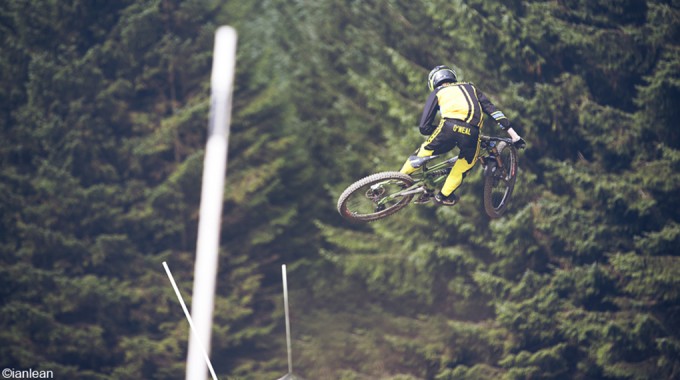
There’s been loads of publicity and comment on the site about the new trails and centres being constructed for mountain bikers on Forestry Commission ground, but there have also been a lot of questions raised as well. Some of these are realistic concerns, some textbook paranoia.
We rang Paddy Harrop of Forest Enterprise to ask him directly what was going on in the woods.
Why do FE suddenly seem to like mountain bikers?That’s an interesting perception, as we’ve actually been doing it for ages. We’ve always had a recreation element, the National Forest Parks of the 1930’s actually pre-dated the National Parks we have now. Although they were mostly fire road trails we’ve actually been creating mountain bike trails since the 80’s. The thing is that the communication is getting better both by us, and the media who are getting excited about it – which is great.
 Shouldn’t you be planting trees instead?
Shouldn’t you be planting trees instead?
For a long time the government has wanted more than trees. We control a million hectares of public land and there’s been a government act in place since the 1950’s saying we have to encourage recreation. The mission statement of FE (a government agency since 1996) includes: “to develop the recreational potential of the estate” and talks about providing public benefit from the land. We have over 50 million leisure visitors a year but only a couple of hundred timber companies.
Is there a sudden craze for mountain biking / petrol rationing amongst FE staff?There is definitely an increase in the number of bikers in the FE as well as people we work closely with, such as; Ian Wardby down at Aston, Karl Bartlett in South Scotland, Phil Lee in Afan Argoed, Adrian Carter from Pace, Rik up at Mabie and loads of others.
We’ve generally found mountain bikers to be really helpful and positive too, which helps massively. It’s easy to be enthusiastic when people like what you’re doing and you’re getting good press, it makes a real change from folk complaining.
The general policy is that cyclists are welcome on hard tracks and roads, as long as they follow the code of contact we worked out with the CTC. Apart from that most development has been of a regional nature in areas like Wales and the south of Scotland. We try and respond to what people want in different areas, which is much more effective than trying to develop an overall strategy.
 How much is the government involved or is this purely an FE initiative?
How much is the government involved or is this purely an FE initiative?
Specific mountain bike routes aren’t governmental but they fulfil a lot of the stated government targets. We’re encouraging health and well being, getting folk back into the countryside after foot and mouth, and we’re getting more people involved in what happens on public land.
Will all trails be set up for the same user groups or to address needs of different bikers?We have to make sure that eveyone gets catered for, but again it’s often a case of regional demand. We’ve got all sorts of different models from Sustrans type routes, to routes we’ve worked out with the Trailcyclists association as well as DH, BSX and Dual courses, singletrack and around 100 – 200 jump spots that we’re aware of. We’re fairly sure there’s some North Shore style stuff too, but we haven’t tracked it down yet.
The DH, BSX and jump spots take the most managing as they are potentially the most dangerous but we’re trying to work with the riders who build them and get them to ask us first, so we can work together from the outset. We’ve got strategies for managing safety aspects, and notes for rangers telling them what to look for and how to best talk to people. In a couple of places we’ve actually got specific management agreements with local clubs and groups.
Yes generally, Last year we held 8 trailbuilding and management workshops, to equip them to deal with mountain biking issues.
Most forest trails so far have been about regenerating economy in remote areas. Have you considered trails in areas close to urban centres?The areas near urban centres tend to have more jump spots rather than riding routes at the moment but we’re working very closely with Community Forest who are a separate partnership between FC and local authorities. The trails in the Welsh valleys and other urban areas are generally their concern.
 Are you planning to make trails pay to ride?
Are you planning to make trails pay to ride?
Not usually no. There are some place like the downhills at Aston and Annoch Moor at Fort William where we’re possibly looking at pay per ride or a club membership just because of the level of investment we’ve made. Car parking, jet washing charges, visitor centre sales etc. generally bring in good revenue, and it would be difficult in some places to police pay for ride charges in most places even if we wanted to.
Loads of bikers have been to Coed-Y-Brenin and Afan Argoed but they won’t go to all the others too – is the Coed-Y-Brenin model being spread too thin?Not yet. There’s still only a dozen good cycling centres across the country and the market is much bigger than that. Mountain bikers are prepared to travel for an hour or two to get a really good ride, and that puts us in reach of a huge number of population centres. We just need to make places different enough to attract people, there’s no point just having an identical Red Bull in every wood.
We can grow the market by developing more entry-level routes too. We have nearly 20,000km of traffic-calmed forest roads under our control and they could attract a huge market .
Not as far as I’m aware, but we have no input on rights of way outside the forests. It’s really important bikers
support access work by the CTC and others, rather than just relying on FE
and other landowners to provide them with routes.
Managed trails actually really help to control safety issues. According to statistics, fire road downhills are our most dangerous features. Off camber corners at speed with loose gravel = nasty accidents. Tight, technical, low speed singletrack actually causes far fewer serious incidents.
 What other groups (inside and outside FE) are you facing pressure from about the increasing number of trails for mountain bikers?
What other groups (inside and outside FE) are you facing pressure from about the increasing number of trails for mountain bikers?
Actually we aren’t. There are local NIMBY’s who complain about everything from trails to tree felling, but no animosity towards bikers. Walkers have had their own trails to keep them occupied for ages, and we’re always talking to the organising bodies of Enduro, canoe, horse, rally and other users trying to help them. There might be some jealousy about the relative spend on trails, but we’re not switching money away from them, it’s extra money we can pull in from outside funds. Besides 1 in 3 people in Britain have a bike, that’s way more than Enduro bikes, canoes or horses, so the market is potentially much bigger.
What can mountain bikers can do to help?Ride the trails is the main thing, but be nice to other visitors when you’re there. Say “Hi’ to walkers, say ‘Hi’ to horses, say ‘Hi’ to other cyclists and if you’ve enjoyed yourself, let people know. Getting involved with organised trailbuilding is also a great help but it has to be done properly, so please ask before you start in with a spade, and we’ll do everything we can to help make it safe and sustainable for us and you.
So there you go, that’s what’s happening in the woods, so get down there and make the most of it!

